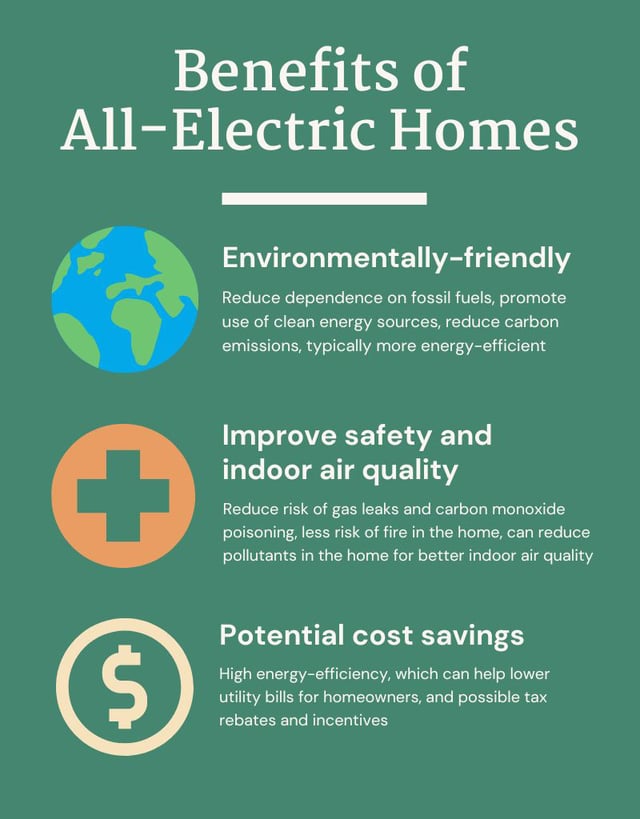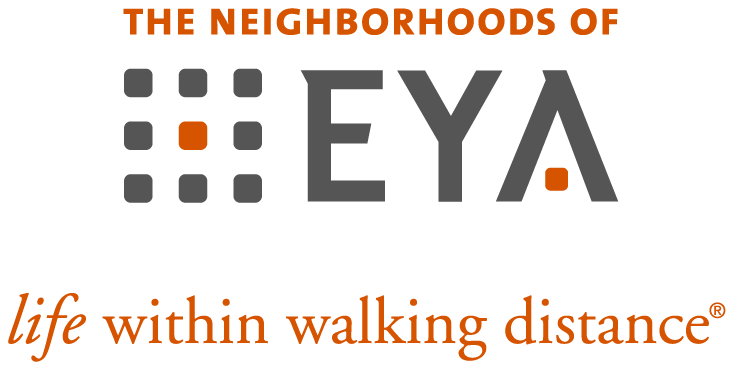Everything you need to know about the benefits of all-electric homes
Design | DC townhomes | New Townhomes | EYA | D.C. Area | Washington, DC | new construction homes | sustainable living | reservoir district | eco-friendly | all-electric home | Westbard Square
By: EYA Homes on August 8th, 2024
When purchasing a new home, many home shoppers are looking for eco-friendly, energy-efficient features that will help reduce their carbon footprint and save money. All-electric homes are becoming a more popular option and another thing to consider when shopping for your next new home.
So what do you need to know about all-electric homes before making your decision? In this blog post, we'll go over all-electric home features, the benefits of all-electric homes, how they could help you save money and live a more eco-friendly lifestyle, and make a positive impact on the environment.
Learn about EYA's approach to building
sustainable neighborhoods
All-Electric Home Features
In an energy-efficient, all-electric home, gas systems and appliances are replaced with their electric counterparts. Eliminating gas in a home not only reduces dependence on fossil fuels, but also can help to improve indoor air quality, reduce the risk of carbon monoxide poisoning and fire hazards, and more.
Two of EYA's newest communities, Reservoir District in DC and The Brownstones at Westbard Square in Bethesda, MD, feature eco-friendly, all-electric design. That means, no gas lines will be run to the homes and all the home systems and appliances will be electric. Examples of all-electric features include the following.

Electric Range & Cooktop
EYA's all-electric communities feature electric ranges and cooktops, with an induction option available. Electric ranges and cooktops can offer increased health and safety benefits as gas-powered appliances release more air pollutants and have higher risk of fire. A Washington Post article noted that gas-powered appliances release "planet-warming gas methane" and "significant amounts of nitrogen dioxide, a pollutant that can trigger asthma and other respiratory conditions."
Our purchasers often have questions about electric vs induction, so we wanted to do a deeper dive on this.
Electric vs Induction Cooktops
Electric and induction cooktops both use electricity to cook food, but they operate differently and have distinct advantages and disadvantages.
Electric Cooktops
How They Work:
- Conventional electric cooktops cook with heat-producing elements beneath the surface. When a burner is turned on, the element generates heat which is transferred to the cooking surface above.
- The glass surface heats the cookware, which then cooks the food.
Advantages:
- Generally less expensive than induction cooktops.
- Available in a wider range of styles and sizes.
- Can use any type of cookware (as long as it has a flat bottom).
Disadvantages:
- Slower to heat up and cool down compared to induction cooktops.
- Less energy-efficient as heat is lost during the transfer from the element to the cookware.
- The surface can get very hot, posing a burn risk.
Induction Cooktops
How They Work:
- Induction cooktops use electromagnetic fields to directly heat the cookware.
- When a magnetic pot or pan is placed on the cooktop, the electromagnetic field generates heat directly in the cookware.
Advantages:
- Very energy-efficient as the heat is generated directly in the cookware.
- Heats up and cools down much faster than electric cooktops.
- The cooktop surface remains relatively cool, reducing the risk of burns and making cleanup easier.
- Precise temperature control.
Disadvantages:
- More expensive than electric cooktops.
- Requires compatible cookware (must be ferromagnetic, like cast iron or some stainless steel - but you may already have these and not need to buy new).
- May produce a humming noise or vibration, especially at higher power levels.
Watch this video
to learn more about induction cooking
Summary:
- Electric cooktops are less expensive and more versatile in terms of cookware but are slower and less efficient.
- Induction cooktops are faster, more efficient, and safer but require compatible cookware and are more expensive.
To learn more about electric vs induction cooktops, additional resources are listed below.
- Forbes - Induction vs Electric Cooktop: What's the Difference?
- Consumer Reports - Induction vs Electric Cooktop: Which Should You Buy?
- Tom's Guide - Induction vs Electric Cooktop: Which Type is Better for You?
So what about the advanced home chefs out there that have loved their gas stovetop? How do they feel about switching from gas to induction, for example? Read a few real life stories below of home chefs experiences switching from gas to induction.
- Epicurious - Induction vs Gas: Why I Said Good-Bye to Open Flame Cooking "Now that I’ve lived with an induction range for three months, I consider myself an induction evangelist. Still, I’m willing to admit induction cooking has its drawbacks, starting with the fact that induction ranges are often about 20% pricier than comparable gas ranges, depending on the brand and retailer. That said, induction cooktops use less energy than any other type of cooktop so it may even out in the end."
- EESI - I Made the Switch from Gas to Electric Cooking: Here's Why I Love My New Induction Stove "We have had the induction stove for a few months now, and it has been fantastic. No complaints or regrets. There was a slight learning curve to figure out how hot a pan would get at different settings, but otherwise the transition has been seamless. The power and precision were better than we had hoped. Cooking with cast iron pans has never been easier. The ability to fine-tune a low simmer, for example, is much better than with our previous gas stove. Water boils incredibly fast, which actually led to one (joking) complaint from Gillian: she was used to chopping vegetables and getting a lot of other meal prep done while waiting for water to boil, but now that timing does not work anymore. Beyond cooking performance, the stovetop is a lot easier to keep clean and we feel safer letting our eight-year-old learn to cook. But the best part is that we no longer have the gas odor (and all that means for our indoor air quality)."
In summary, benefits of electric/induction cooktops include: Uses cleaner electric energy, improved indoor air quality for homeowners, energy-efficient, eliminates risk of carbon monoxide from a gas leak, better for the environment, reduces risk of potential fire
Electric, Demand-Control Water Heater
In many homes with a conventional central water heater, not only is more energy used to constantly heat and store the hot water, but also the cold water currently in the pipes is wasted down the drain as you wait for the hot water to reach the faucet.
An electric, demand-control recirculating water heater not only uses cleaner electric energy, but also does not waste cold water. When you turn on a switch (just like a light switch!), the system starts recirculating cool water that's been sitting in the hot water line and quickly sends it back to the water heater then to the faucet. Once the water reaches a desired temperature, the pump automatically shuts off.
Benefits of electric, demand-control water heaters include: Uses cleaner electric energy, reduces energy use as it is demand-controlled, no wasted water, potential cost savings on utility bills compared to conventional systems
Click here to learn more about electric, demand-control recirculating water heaters.
Electric HVAC System
A recent article by the U.S. Energy Information Agency states that on average, more than half of a household’s annual energy consumption comes from heating and cooling the home. An efficient HVAC system can not only help to reduce utility bills, but a modern electric system can also significantly reduce reliance on fossil fuels. Furthermore, gas furnaces pose a higher risk of gas leak, fire and carbon monoxide poisoning compared to electric heat pumps.
Benefits of electric HVAC systems include: Uses cleaner electric energy, eliminates risk of carbon monoxide from a gas leak, improved indoor air quality, potential cost savings on utility bills compared to gas-powered systems

Optional Electric Fireplace
EYA all-electric communities offer an optional electric fireplace. An electric fireplace can provide many of the same benefits as other electric appliances. These may include less energy use, cleaner source of energy, eliminate risk of gas leak and gas pollutants, improved indoor air quality and more. Electric fireplaces can offer a streamlined presentation, and opportunity to customize the flame and elements such as use of natural-looking logs vs more modern glass or stone to suit the homeowner’s taste and décor.
Benefits of electric fireplaces include: Uses cleaner electric energy, improved indoor air quality for homeowners, eliminates risk of carbon monoxide from a gas leak, better for the environment
Benefits of an All-Electric Home

As noted, there are numerous benefits of an all-electric home both for the homeowners and the environment.
Environmentally-Friendly
- Reduce dependence on fossil fuels: All-electric homes eliminate the need for fossil fuels, reducing dependency on non-renewable resources and promoting cleaner energy consumption.
- More environmentally-friendly: All-electric homes reduce carbon emissions, helping you reduce your carbon footprint. By using electricity as the primary energy source for heating, cooling, cooking, and powering household appliances, these homes can contribute to a cleaner environment.
Homeowner Comfort & Safety
- Improved safety: With all-electric homes, there is no risk of gas leaks or carbon monoxide poisoning associated with gas-powered appliances. Additionally, with no open flames, there is less risk of fire in the home.
- Better indoor air quality: Electric appliances can provide better indoor air quality compared to their gas counterparts, as they do not produce combustion byproducts or emissions.
- One less utility to manage: All-electric homes offer the added convenience of one less utility to manage and maintain, and one less bill to pay.
Potential Cost Savings
- Potential cost savings for homeowners: All-electric homes typically are highly energy-efficient, which can help lower utility bills for homeowners.
- Incentives and rebates: There may be incentives and tax rebates for further cost savings.
EYA all-electric communities also offer optional EV charging and solar rough-ins. Potential cost savings for these include:
- EV Charging - IRS: Alternative Fuel Vehicle Refueling Property Credit "For consumers who purchase and install qualified alternative fuel vehicle refueling property for their principal residence, including electric vehicle charging equipment, between December 31, 2022, and January 1, 2033, the tax credit equals 30% of the cost with a maximum amount of $1,000 per item."
- Solar Panels - IRS: Residential Clean Energy Credit "The Residential Clean Energy Credit equals 30% of the costs of new, qualified clean energy property for your home installed anytime from 2022 through 2032." (qualified expenses include solar electric panels)
We hope this has been helpful information as you consider energy-efficient features in your next new home, including the option for all-electric. To learn more about EYA's all-electric communities, click here for Reservoir District in DC and here for The Brownstones at Westbard Square in Bethesda, MD.


